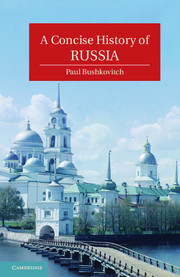Book contents
- Frontmatter
- Contents
- List of Figures
- Abbreviations
- Acknowledgments
- Prologue
- 1 Russia before Russia
- 2 Moscow, Novgorod, Lithuania, and the Mongols
- 3 The Emergence of Russia
- 4 Consolidation and Revolt
- 5 Peter the Great
- 6 Two Empresses
- 7 Catherine the Great
- 8 Russia in the Age of Revolution
- 9 The Pinnacle of Autocracy
- 10 Culture and Autocracy
- 11 The Era of the Great Reforms
- 12 From Serfdom to Nascent Capitalism
- 13 The Golden Age of Russian Culture
- 14 Russia as an Empire
- 15 Autocracy in Decline
- 16 War and Revolution
- 17 Compromise and Preparation
- 18 Revolutions in Russian Culture
- 19 Building Utopia
- 20 War
- 21 Growth, Consolidation, and Stagnation
- 22 Soviet Culture
- 23 The Cold War
- Epilogue
- Further Reading
- Index
6 - Two Empresses
Published online by Cambridge University Press: 05 June 2012
- Frontmatter
- Contents
- List of Figures
- Abbreviations
- Acknowledgments
- Prologue
- 1 Russia before Russia
- 2 Moscow, Novgorod, Lithuania, and the Mongols
- 3 The Emergence of Russia
- 4 Consolidation and Revolt
- 5 Peter the Great
- 6 Two Empresses
- 7 Catherine the Great
- 8 Russia in the Age of Revolution
- 9 The Pinnacle of Autocracy
- 10 Culture and Autocracy
- 11 The Era of the Great Reforms
- 12 From Serfdom to Nascent Capitalism
- 13 The Golden Age of Russian Culture
- 14 Russia as an Empire
- 15 Autocracy in Decline
- 16 War and Revolution
- 17 Compromise and Preparation
- 18 Revolutions in Russian Culture
- 19 Building Utopia
- 20 War
- 21 Growth, Consolidation, and Stagnation
- 22 Soviet Culture
- 23 The Cold War
- Epilogue
- Further Reading
- Index
Summary
With the restoration of autocracy, Anna came to the throne as Empress of Russia, and after a time she sent the leaders of the Golitsyn and Dolgorukii clans into exile. The ten years of Anna's reign in the memory of the Russian nobility was a dark period of rule by Anna's German favorites – particularly her chamberlain – Ernst-Johann Bühren (Biron to the Russians), who was allegedly all-powerful and indifferent to Russian interests. That memory was a considerable exaggeration. After a brief interlude, Empress Elizabeth, Peter the Great's daughter and a capable and strong monarch succeeded her (1741–1761). Underneath all the drama at court, Russia's new culture took shape, and Russia entered the age of the Enlightenment. In these decades we can also get a glimpse of Russian society that goes beyond descriptions of legal status into the web of human relations.
Politically Anna's court was not a terribly pleasant place, though the story of “German domination” is largely a legend. Anna was personally close to Biron, who had served her well in Courland, where she had lived since the death of her husband the duke in 1711. She entrusted foreign policy to Count Andrei Ostermann and the army to Count Burkhard Christian Münnich, but the three were in no sense a clique. Indeed, they hated one another and made alliances with the more numerous Russian grandees in the court and in the government. The truth was that Anna relied on them and a few others and she did not consult with the elite as a whole. The Senate languished. Not surprisingly, Anna was terrified that there would be plots against her in favor of Elizabeth, Peter's eldest surviving daughter, or other candidates for the throne, and she used the Secret Chancellery to try to uncover them. The darkest episode of the reign was the trial and execution of her minister Artemii Volynskii in 1740 on the charge of insulting the Empress. This was an excuse: the real reason for his death was Volynskii's loss of favor with Biron and Ostermann and his own ambitious plans, which frightened Anna and many others in her entourage.
- Type
- Chapter
- Information
- A Concise History of Russia , pp. 101 - 116Publisher: Cambridge University PressPrint publication year: 2011

